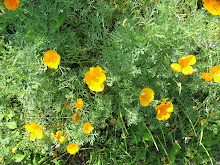
I returned today to the garden after a week-long absence to pick a few tomatoes and a bouquet. Also to survey the results of last Thursday's work evening. It's been my unfortunate luck that I have missed the last three work days, due to vacation plans, a course that meets Wednesday nights, and a crunch time at work. Luckily, my husband Steve and I had the foresight to sign up for mowing, a monumental task that we never quite completed, even after fulfilling the annual 4 work hours required and then some. The much-touted riding mower was awaiting parts, so we had to switch off using the one operational gas-powered push mower and our electric mower. It was a struggle to tame the overgrown grass, constantly wet from the intermittent July rains. Still, I would still recommend signing up to mow to any gardener who has had difficulty making it to the work events. It's not unusual for plot holders to find that September has arrived and they are an hour or two shy of meeting their work requirement.
The July work evening was nearly rained out, but without having heard a report, I could tell that last week's was much more productive. Most of the various trees and other native plantings in the area at the corner of Williams Street and Dungarven Road are no longer choked by weeds, and the length of the grass no longer inhibits anyone from walking right up to them. Also, many gardeners heeded the call to weed the section of path adjacent to their plots, so in general the place is now "under control," though thankfully (in my opinion) not too manicured and sterile.
In a neighborhood as diverse at Stoneybrook, there are always bound to be different standards for how neat and tidy a community garden should be. What some might regard as the natural beauty of native plants might be seen by others as a bunch of tick-harboring weeds. In meetings there has been much debate over how much should be allowed to remain wild. Another related issue concerns what should be allowed to exist on the property. I remember the controversy over some wood preserved after the demolition of the old Minton Stable barn back in the mid-1990s. Some gardeners had grand plans for the 10-inch southern yellow pine planks to be used to build a shed, while others saw the wood pile as an eyesore. The boards became punky and eventually had to be removed.
My general feeling is that a border of native plantings provides a needed buffer between the property and the street and abutters, and is also important for attracting butterflies, birds, and other wildlife. However, during my mowing last month as I encountered asters, black-eyed susans and other plants running rampant, I was unsure of where that line should be drawn.


No comments:
Post a Comment